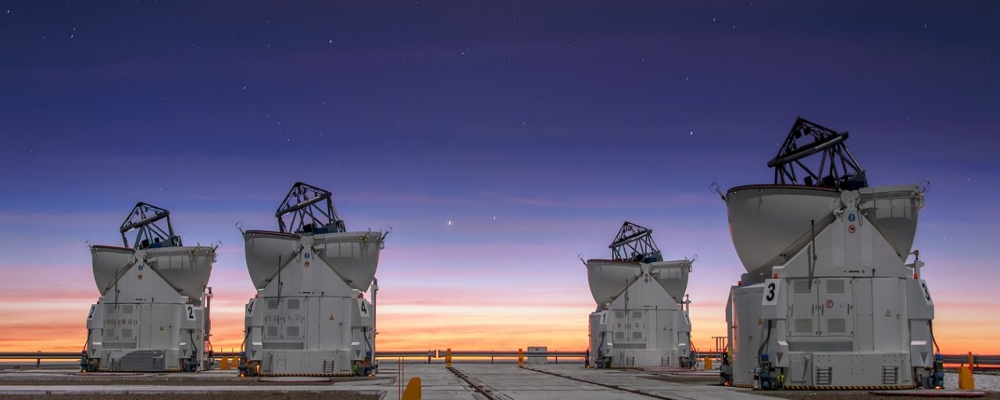NAOMI Science Verification with GRAVITY and PIONIER

Accepted Proposals
Prod. ID |
P.I. |
Title |
Instrument |
Priority |
status |
| 60.A-9131 | Sebastián Zúñiga-Fernández | The quadruple pre-main sequence system HD 98800 | PIONIER | High | completed |
| 60.A-9132 | Jacques Kluska | Detecting the inner disk precession in a protoplanetary disk | GRAVITY | High | completed |
| 60.A-9133 | Henri Boffin | Detecting the tidal deformation of red giants in symbiotic systems | PIONIER | High | completed |
| 60.A-9134 | Lucia Klarmann | Tracing carbon in the region of terrestrial planet formation | GRAVITY | High | completed |
| 60.A-9135 | Lei Chen | High-precision interferometry of the faint sub-au dust around the Herbig star HD 169142 | PIONIER | Low | completed |
| 60.A-9136 | Alexander Kreplin | First direct observations of temporal changes in the geometry of magnetically-confined plasma in a rotating magnetosphere outside our solar system | GRAVITY | Low | completed |
| 60.A-9137 | Aaron Labdon | Resolving disk misalignments and individual geometries of the unique edge-on binary system PDS 144 | PIONIER | Low | Partial (very faint and resolved) |
| 60.A-9138 | Markus Wittkowski | Characterizing the surface structure of the red supergiant V602 Car | PIONIER | Low | completed |
Since November 2018, the four Auxitiliary Telescopes (ATs) at VLTI are equipped with the adaptive optics NAOMI systems (annoucement).
ESO wishes to demonstrate NAOMI new capabilities with the PIONIER and GRAVITY instruments during a Science Verification period. 5 nights with the ATs will be devoted to the NAOMI Science Verification (SV) starting on May 7 2019.
All astronomers are invited to participate in this opportunity to demonstrate the improved capabilities of PIONIER and GRAVITY in terms of sensitivity (+1mag in limiting magnitude compared to the P103 call for proposal) and precision in visibility and closure phase (typically be a factor 2 to 3). Improved precision is important for targets with high contrast (e.g. a star+disk or star+faint companion, etc.) and/or highly resolved sources (i.e. low visibilities). These improvements require to full-AO correction, when the guide star is brighter than R=12.5.
A call for SV proposals has been issued and the community is invited to submit proposals for the NAOMI SV using this proposal template and associated LaTeX file.
The offered PIONIER and GRAVITY modes for NAOMI SV are the same as for P103 (see the GRAVITY and PIIONIER instrument pages). Here are the limiting magnitudes for GRAVITY (K band) and PIONIER (H band), for the best observational conditions:
| GRAVITY | Klim |
|---|---|
| single field & FT dual field "on-axis" |
9.0 |
| SC dual field "on-axis" | 9.0+3.0 |
| FT dual field "off-axis" | 9.5 |
| SC dual field "off-axis" | 9.5+3.0 |
| PIONIER | Hlim |
|---|---|
| Free | 9.0 |
| Grism | 8.5 |
The observations will be conducted in Service Mode by a dedicated team of ESO astronomers. The NAOMI SV team will be able to assist the successful PI¹s in the preparation and optimisation of the OBs on a best effort basis only. The collected data will be made available to the whole ESO user community.
GTO protected targets
The list of protected targets for the VLTI instruments Guaranteed Time Observations is available for P103. Observations of targets protected by the GTO will not be accepted for SV.
WARNING: all (raw) data and calibrations are public immediately after the observations. There is no proprietary period nor earlier data release to the PIs. See the VLT Science Verification Policy and Procedures for more details.
- Jean-Philippe Berger (NAOMI)
- Xavier Haubois (ESO)
- Christian Hummel (ESO)
- Jean-Baptiste Le Bouquin (NAOMI)
- Antoine Mérand (ESO)
- Anna Pala (ESO)
- Claudia Paladini (ESO)
- Thomas Rivinius (ESO)
- Linda Schmidtobreick (ESO)
- Konrad Tristram (ESO)
- Markus Wittkowski (ESO)
- Julien Woillez (ESO)
Schedule
21st December 2018: Issue Call for Proposals
21st January 2019: Deadline for proposal submission
22nd February 2019: Proposers informed about the outcome
22nd March 2019: Deadline for Phase 2 Material for SV
7th May 2019: Science Verification
General Information
An integral part of the commissioning of a new instrument at the VLT is the Science Verification phase. SV programmes include a set of typical scientific observations that should verify and demonstrate to the community the capabilities of the new instrument in the operational framework of the VLT Observatory. See the SV Policy and Procedures: http://www.eso.org/sci/activities/vltsv/svdoc.pdf
